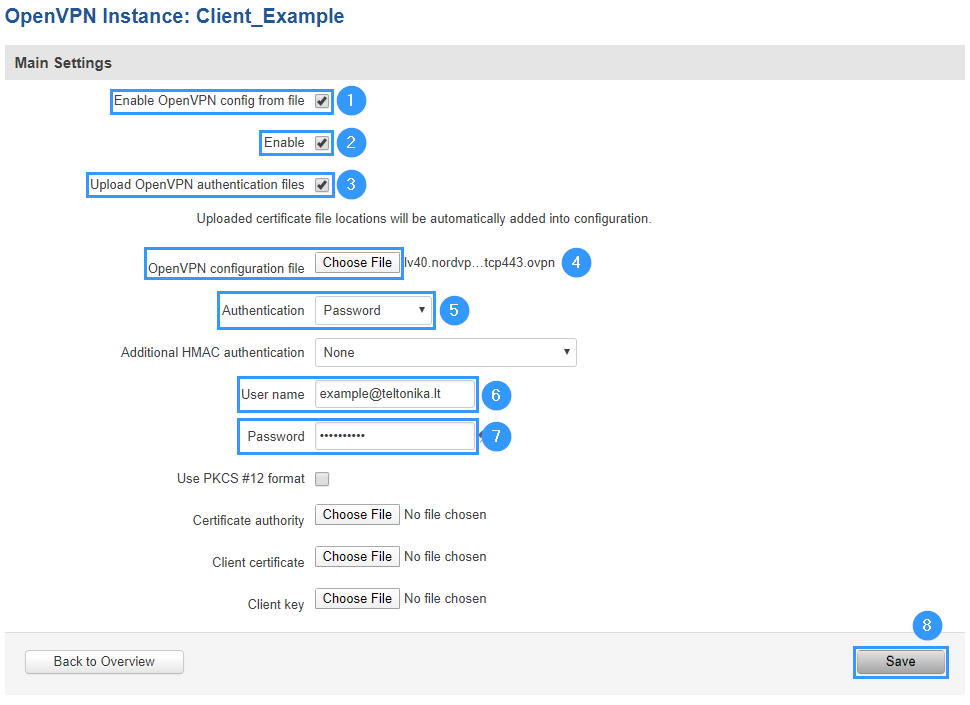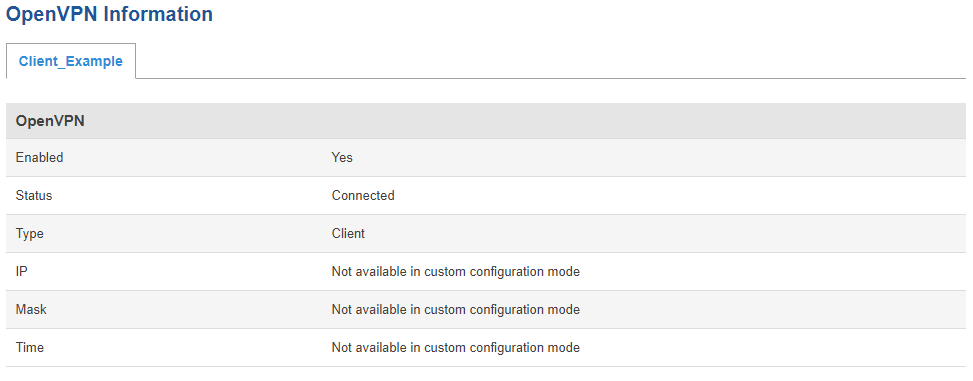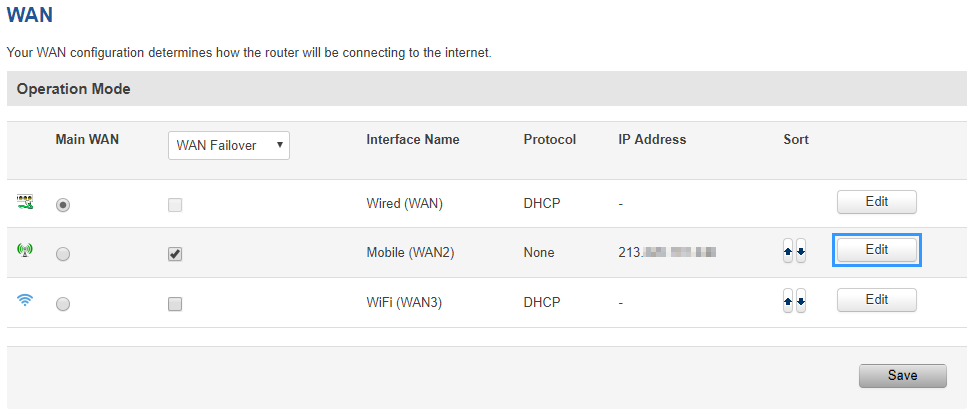Template:Netoworking rut2xx configuration example nordvpn: Difference between revisions
(Created page with "NordVPN is a personal virtual private network (VPN) service provider. It is supported on various different devices and RUTX routers are one of those. ==Introduction== This a...") |
No edit summary |
||
| (7 intermediate revisions by the same user not shown) | |||
| Line 1: | Line 1: | ||
NordVPN is a personal virtual private network (VPN) service provider. It is supported on various different devices and | NordVPN is a personal virtual private network (VPN) service provider. It is supported on various different devices and RUT2xx routers are one of those. | ||
==Introduction== | ==Introduction== | ||
This article contains step-by-step instructions on how to set up '''NordVPN''' VPN connection using | This article contains step-by-step instructions on how to set up '''NordVPN''' VPN connection using RUT2xx routers. | ||
==Prerequisites== | ==Prerequisites== | ||
| Line 9: | Line 9: | ||
You will need: | You will need: | ||
* One | * One RUT2xx router | ||
* An end device to configure the router (PC, Laptop, Tablet, Smartphone) | * An end device to configure the router (PC, Laptop, Tablet, Smartphone) | ||
* NordVPN account and subscription | * NordVPN account and subscription | ||
| Line 17: | Line 17: | ||
In order to setup your router to connect to NordVPN server you will need to download OVPN configuration files. Those can be found at [https://nordvpn.com/ovpn/ NordVPN website]. It is necessary to choose a server which can provide the best possible performance, visit this [https://nordvpn.com/servers/tools/ website] and it will automatically show you which server will provide you the best experience. Also when it comes to choosing TCP or UDP you need to decide what you are trying to achieve. TCP is reliable, data sent using this protocol is guaranteed to be delivered to the receiver. If data is lost in transit it will recover the data and resend it. TCP will also check packets for errors and track packets so that data is not lost or corrupted, but that effects internet speed. UDP is unreliable, it does not provide guaranteed delivery and a datagram packet may become corrupt or lost in transit, but you will get greater internet speed. | In order to setup your router to connect to NordVPN server you will need to download OVPN configuration files. Those can be found at [https://nordvpn.com/ovpn/ NordVPN website]. It is necessary to choose a server which can provide the best possible performance, visit this [https://nordvpn.com/servers/tools/ website] and it will automatically show you which server will provide you the best experience. Also when it comes to choosing TCP or UDP you need to decide what you are trying to achieve. TCP is reliable, data sent using this protocol is guaranteed to be delivered to the receiver. If data is lost in transit it will recover the data and resend it. TCP will also check packets for errors and track packets so that data is not lost or corrupted, but that effects internet speed. UDP is unreliable, it does not provide guaranteed delivery and a datagram packet may become corrupt or lost in transit, but you will get greater internet speed. | ||
== | ==RUT2xx configuration== | ||
Access | Access RUT2xx WebUI and go to '''Services > VPN > OpenVPN'''. There create a new configuration by selecting role '''Client''', writing '''New configuration name''' and pressing '''Add New''' button. It should appear after a few seconds. Then press '''Edit'''. | ||
[[File: | [[File:Networking_rut_configuration_example_nordvpn_1_v1.png|border|class=tlt-border]] | ||
Now apply the following configuration. | Now apply the following configuration. | ||
[[File: | [[File:Networking_rut_configuration_example_nordvpn_2_v1.png|border|class=tlt-border]] | ||
# '''Enable OpenVPN config from file''' feature. | # '''Enable OpenVPN config from file''' feature. | ||
| Line 34: | Line 34: | ||
# Write NordVPN account '''User name'''. | # Write NordVPN account '''User name'''. | ||
# Write NordVPN account '''Password'''. | # Write NordVPN account '''Password'''. | ||
# Press '''Save | # Press '''Save'''. | ||
You will be forwarded back to '''OpenVPN configuration''' window | You will be forwarded back to '''OpenVPN configuration''' window. | ||
[[File: | You can check whether you applied the configuration correctly. Go to '''Status > Network > OpenVPN''' it should indicate as '''Connected'''. (It might not connect instantly so please wait for a moment). | ||
[[File:Networking_rut_configuration_example_expressvpn_2_v1.png|border|class=tlt-border]] | |||
Now you need to configure your router to use NordVPN DNS servers. In order to do that go to '''Network > WAN''', there click '''Edit''' on a WAN source you are using (in this example we used mobile WAN source). | Now you need to configure your router to use NordVPN DNS servers. In order to do that go to '''Network > WAN''', there click '''Edit''' on a WAN source you are using (in this example we used mobile WAN source). | ||
[[File: | [[File:Networking_rut_configuration_example_nordvpn_4_v1.png|border|class=tlt-border]] | ||
Now to set DNS servers follow the steps below. | Now to set DNS servers follow the steps below. | ||
[[File: | [[File:Networking_rut_configuration_example_nordvpn_5_v1.png|border|class=tlt-border]] | ||
# Disable '''DNS servers advertised by peer'''. | # Disable '''DNS servers advertised by peer'''. | ||
# Add first DNS server: '''103.86.96.100'''. | # Add first DNS server: '''103.86.96.100'''. | ||
Revision as of 18:09, 25 March 2020
NordVPN is a personal virtual private network (VPN) service provider. It is supported on various different devices and RUT2xx routers are one of those.
Introduction
This article contains step-by-step instructions on how to set up NordVPN VPN connection using RUT2xx routers.
Prerequisites
You will need:
- One RUT2xx router
- An end device to configure the router (PC, Laptop, Tablet, Smartphone)
- NordVPN account and subscription
Choosing and downloading server files
In order to setup your router to connect to NordVPN server you will need to download OVPN configuration files. Those can be found at NordVPN website. It is necessary to choose a server which can provide the best possible performance, visit this website and it will automatically show you which server will provide you the best experience. Also when it comes to choosing TCP or UDP you need to decide what you are trying to achieve. TCP is reliable, data sent using this protocol is guaranteed to be delivered to the receiver. If data is lost in transit it will recover the data and resend it. TCP will also check packets for errors and track packets so that data is not lost or corrupted, but that effects internet speed. UDP is unreliable, it does not provide guaranteed delivery and a datagram packet may become corrupt or lost in transit, but you will get greater internet speed.
RUT2xx configuration
Access RUT2xx WebUI and go to Services > VPN > OpenVPN. There create a new configuration by selecting role Client, writing New configuration name and pressing Add New button. It should appear after a few seconds. Then press Edit.
Now apply the following configuration.
- Enable OpenVPN config from file feature.
- Enable instance.
- Allow Upload OpenVPN authentication files.
- Upload OpenVPN configuration file (the one you downloaded from NordVPN website).
- Set Authentication to Password.
- Write NordVPN account User name.
- Write NordVPN account Password.
- Press Save.
You will be forwarded back to OpenVPN configuration window.
You can check whether you applied the configuration correctly. Go to Status > Network > OpenVPN it should indicate as Connected. (It might not connect instantly so please wait for a moment).
Now you need to configure your router to use NordVPN DNS servers. In order to do that go to Network > WAN, there click Edit on a WAN source you are using (in this example we used mobile WAN source).
Now to set DNS servers follow the steps below.
- Disable DNS servers advertised by peer.
- Add first DNS server: 103.86.96.100.
- Add second DNS server: 103.86.99.100.
- Press Save & Apply.
Testing configuration
If configured correctly all of your internet traffic now should go through VPN server. One of the easiest ways to check whether everything is working correctly is to check whether your public IP address has changed. You can do so by simply visiting a website such as www.whatismyipaddress.com and comparing your IP address before and after you connect to server also there you can find information about IP location, so when you connect to server it should change to a different address/country. Or you can visit NordVPN website and there on the very top of the website you can indicate whether you are protected or not.
External links
Disclaimer:
Any of the trademarks, service marks, collective marks, design rights or similar rights that are mentioned, used or cited in the articles are the property of their respective owners.





